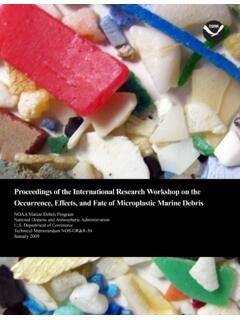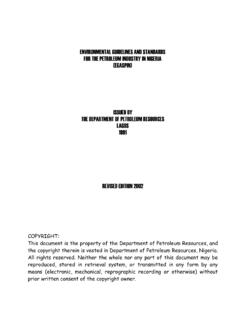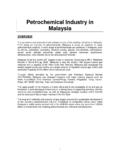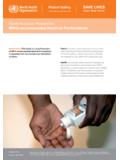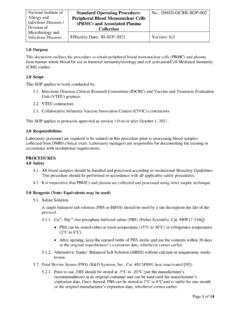Transcription of Laboratory Methods for the Analysis of Microplastics in ...
1 Photo credit: NOAA Marine Debris Program Laboratory Methods for the Analysis of Microplastics in the Marine Environment: Recommendations for quantifying synthetic particles in waters and sediments NOAA Marine Debris Program National Oceanic and Atmospheric Administration Department of Commerce Technical Memorandum NOS-OR&R-48. July 2015. Mention of trade names or commercial products does not constitute endorsement or recommendation for their use by the United States government. Laboratory Methods for the Analysis of Microplastics in the Marine Environment Recommendations for quantifying synthetic particles in waters and sediments Julie Masura1, Joel Baker1, Gregory Foster2, and Courtney Arthur3,4.
2 Carlie Herring, Technical Editor3,4. 1. Center for Urban Waters, University of Washington, Tacoma WA. 2. Department of Chemistry and Biochemistry, George Mason University, Fairfax VA. 3. Systems Group, Rockville MD. 4. National Oceanic and Atmospheric Administration, Marine Debris Division, Silver Spring MD. The suggested citation for this document is: Masura, J., et al. 2015. Laboratory Methods for the Analysis of Microplastics in the marine environment: recommendations for quantifying synthetic particles in waters and sediments.
3 NOAA Technical Memorandum NOS-OR&R-48. For copies of this document, please contact: NOAA Marine Debris Division 1305 East-West Highway Silver Spring, MD 20910 USA. Acknowledgements The NOAA Marine Debris Program would like to acknowledge Sherry Lippiatt, Sarah Opfer Lowe, and Nir Barnea (NOAA National Ocean Service, Marine Debris Program) for reviewing this manual and providing helpful comments and Asma Mahdi for design and layout. Funding for this project was provided by the NOAA Marine Debris Program.
4 This publication does not constitute an endorsement of any commercial product or intend to be an opinion beyond scientific or other results obtained by the National Oceanic and Atmospheric Administration. No reference shall be made to NOAA, or this publication furnished by NOAA, to any advertising or sales promotion which would indicate or imply that NOAA recommends or endorses any proprietary product mentioned herein, or which has as its purpose an interest to cause the advertised product to be used or purchased because of this publication.
5 Although released by NOAA, the information in this paper does not reflect, represent, or form any part of the support of the policies of NOAA or the Department of Commerce. i|Page Laboratory Methods for the Analysis of Microplastics Table of Contents Acknowledgements ..i Abbreviations ..iii Microplastics Background .. 1. Introduction to Methods Manual .. 2. Methods for the Analysis of Microplastics in Water Samples .. 3. Apparatus and Materials .. 7. Wet 8. Transfer Sieved 8. Determine the Mass of Total Solids.
6 8. Wet Peroxide Oxidation (WPO).. 9. Density 10. Microscope 11. Gravimetric Analysis ..12. Methods for the Analysis of Microplastics in Beach 13. Apparatus and Materials ..15. Beach Sediment Sample Preparation ..16. Density Determine the Mass of Total Solids ..17. Wet Peroxide Oxidation (WPO)..18. Density 18. Microscope 19. Gravimetric Analysis ..19. Methods for the Analysis of Microplastics in Bed Samples .. 20. Apparatus and Materials ..22. Bed Sediment Sample Preparation .. 23. Wet Sieving and Transfer of Sieved Solids.
7 23. Determine the Mass of Total Solids (Sample Matrix)..23. Density Determine the Mass of Total Solids ( Microplastics and Natural Materials) ..24. Wet Peroxide Oxidation (WPO)..24. Density 25. Microscope 25. Gravimetric Analysis ..25. Cited 26. Appendices .. 27. Appendix of Calculations .. 27. Appendix of guidelines and Considerations ..29. Note: All photos are credited to the University of Washington, Tacoma (with the exception of the cover photo to which the photo credit is the NOAA Marine Debris Program).
8 Ii | P a g e Laboratory Methods for the Analysis of Microplastics Abbreviations (aq) aqueous Fe(II) iron (II). NaCl sodium chloride (a salt). NOAA National Oceanic and Atmospheric Administration NOS National Ocean Service OR&R NOAA Office of Response and Restoration PVC polyvinylchloride WPO* wet peroxide oxidation 40X magnification with light microscopy by 40 times Units C Celsius d density g gram h hour in inch M Molar mg milligram mL milliliter mm millimeter min minute *The Wet Peroxide Oxidation (WPO) process results in a highly reactive mixture.
9 Please review your Laboratory safety practices and policies before completing this Analysis . In this manual, we have highlighted the WPO steps with a CAUTION note. iii | P a g e Laboratory Methods for the Analysis of Microplastics Microplastics Background Over the past decade, microplastic debris in both marine and freshwater systems has become an emerging issue. There is an increased interest to understand the impacts of Microplastics on aquatic wildlife, as the impacts still remain poorly understood (Thompson et al.)
10 2004, Browne et al. 2007). Microplastics were first noted in North America as spherules in plankton tows along the coast of New England in the 1970s (Carpenter et al. 1972). Since then, Microplastics have been found in most large bodies of water (oceans, seas, lakes, and rivers). Microplastics are plastic particles smaller than mm in size (Arthur et al. 2009). The lower bound (size) of the Microplastics is not defined; however, it is common practice to use the mesh size (333 m or ) of the neuston nets used to collect the samples (Arthur et al.

